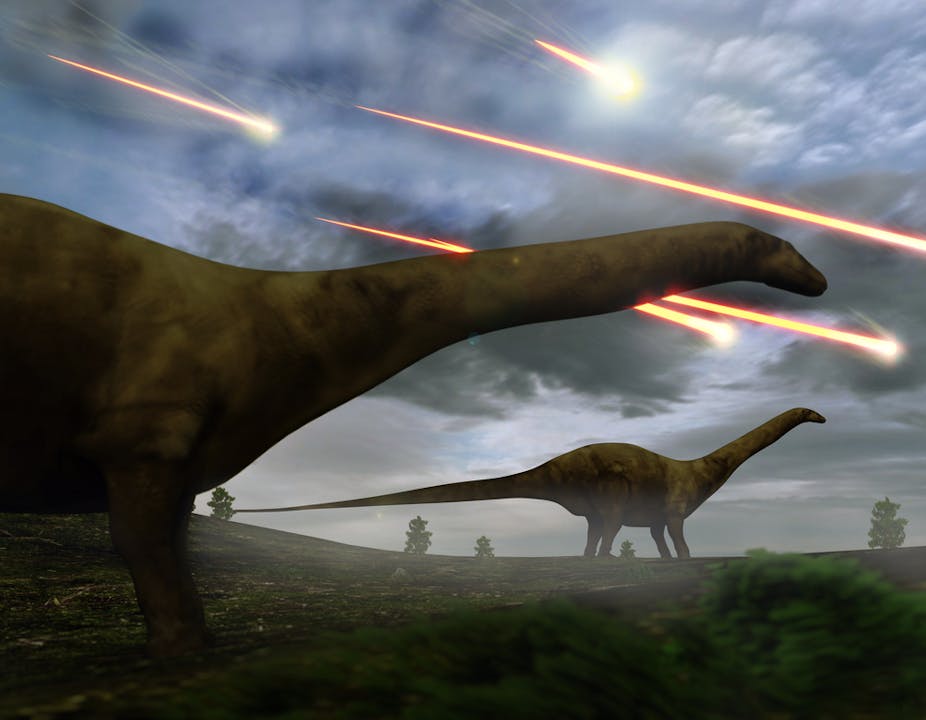When the dinosaurs were wiped off the face of the planet, how did they leave? Was it a slow, plodding decline or a short sharp bang? Back in the 1960s and 1970s, debate about this question was mainly taking place on the ground, at fossil sites in places like Montana. Paleontologist Robert Sloan and his colleagues documented evidence for the long-term decline of dinosaurs over a 10m to 20m-year period. Dinosaurs had been losing out, ever so slowly, to the rising mammals, mainly as a result of cooling climates.
Indeed, climates at this time were cooling. And because dinosaurs relied on the external environment to maintain their body temperatures, this would have hurt them.
But two revelations dramatically switched the consensus against gradual decline. First, the geological field evidence suggested no gradual decline in dinosaur fossils in the rocks. Plus the overlap of declining dinosaurs and rising mammals noted by Sloan turned out to be based on faulty fieldwork and fossil dating. Fossils can be moved from one type of rock to another by being “reworked” or eroded, moved along and then deposited for a second time in younger rocks, providing misleading information about their true age.
The other revelation was the 1980 discovery by Luis Alvarez, which showed that the Earth had been struck by a huge meteorite 66m years ago. It was a collision that threw up vast tonnages of black dust into the atmosphere, which blacked out the sun, leading to freezing and darkness for some months. This was accepted reluctantly at first by geologists, but then enthusiastically as the evidence accumulated.
Impact and sudden death of the dinosaurs made complete sense. The last dinosaurs, such as Triceratops and Tyrannosaurus rex, were imagined as dumbfounded by the asteroid streaking through the sky, and killed wholesale by a consequent fireball and then freezing darkness.
But did the dinosaurs really disappear with a bang? New evidence now suggests instead a very, very, long decline, perhaps as long as 40m years. Part of this comes from our application of a modelling technique to the data. The key here is to have an evolutionary tree, what is known as a “phylogeny”, which is dated accurately against geological time. Although the fossil record of dinosaurs is incomplete and patchy, we do have high quality phylogenies, tested over 30 years of research, that provide solid information on dinosaurian relationships.
Once you have a phylogeny, and date it against a geological time scale, you can read off a great deal of new information. It helps to joins the dots, linking isolated finds, and bridging gaps. It also provides a framework from which rich data on rates of evolution can be calculated.
We wanted to explore a hint of decline that had been noted in the first such comparative phylogenetic analysis.Our new work focused on exploring the diversity dynamics of dinosaurs through their entire evolution. We confirmed first that they did most of their evolving in the first half of their reign on Earth, during the late Triassic and early to middle Jurassic periods, some 230m to 150m years ago.
Decline and fall
Most importantly, we found clear evidence for a long-term decline from 40m years before the end of the Cretaceous period. We looked at all dinosaurs, and then each of the main subgroups. The only exceptions were the duck-billed dinosaurs (hadrosaurs) and the horned ceratopsians, both of which showed renewed bursts of evolving into new distinct species later on.
So after so much recent disagreement, can our new theory be believed? We believe so. It is based on the most detailed data ever assembled, a complete evolutionary tree of more than 600 species of dinosaurs, with better control on the time scale than ever before.
The result was obtained through modelling of the data using an approach which allowed us to repeat the calculations millions of time, using different assumptions about uncertainties each time, to see whether the analysis converged on a single result. In this case, we modelled uncertainties in the phylogeny, in geological dating, and in sampling, and tried every variant of the data, and the result was robust. We can now say categorically: for their final 40m years on Earth, the dinosaurs were in decline - their rate of species extinction was on average consistently higher than their rate of forming new and distinct species (speciation).
But what we cannot yet explain is why this was so. We found correlation of our speciation dynamics data with sea level, but a more detailed exploration is needed of the impact of cooling climates and their interactions with other species such as mammals. Whatever the driver, dinosaurs were declining. They went out with a long, protracted whimper … followed by that almighty meteoric bang.

